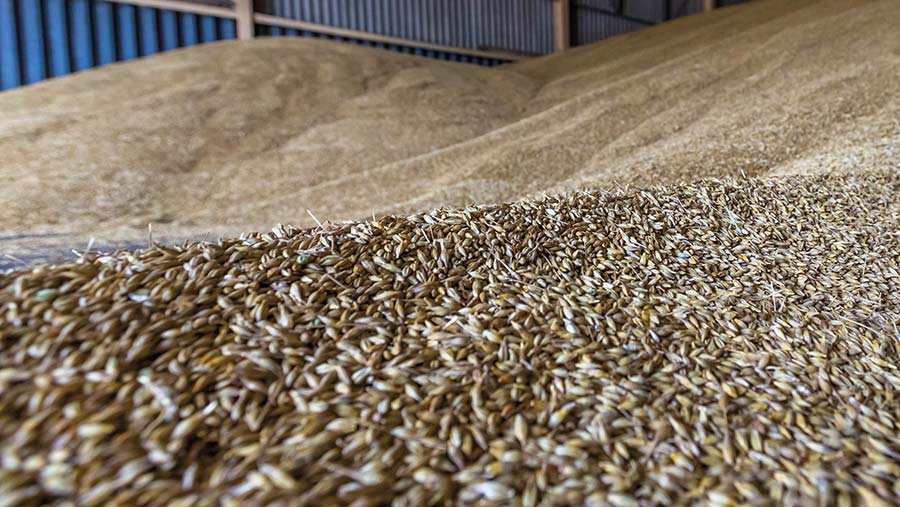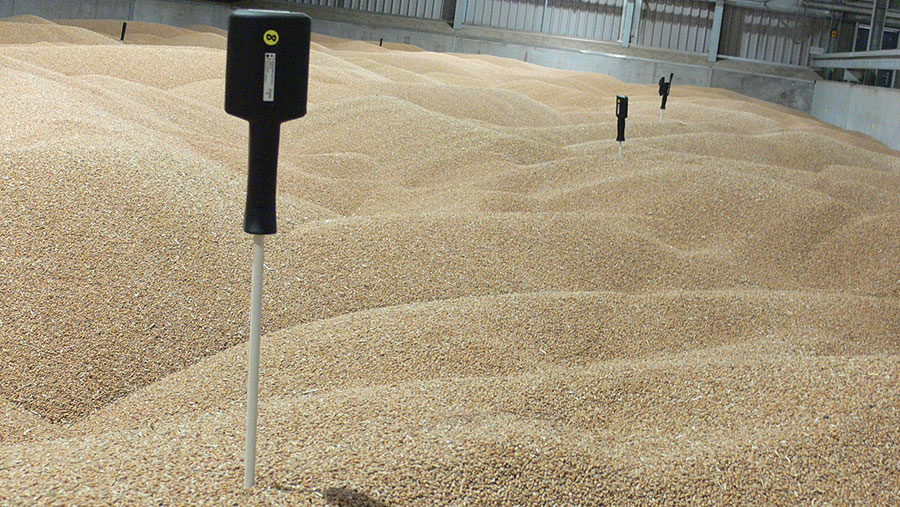Tips to achieve successful long-term grain storage
 © Tim Scrivener
© Tim Scrivener There are many factors to take into consideration when storing grain crops for the long term. Getting it wrong means quality will deteriorate, which can lead to significant financial losses.
According to Andrew Head, managing director of grain handling specialist BDC Systems, the main challenges of grain storage on farm are reducing moisture levels and getting temperatures down as quickly as possible.
See also: What exactly is vigour and how can it help you choose the right OSR variety?
When treated properly, grains such as wheat, barley and oats can be stored for many years, enabling farmers to wait for higher prices – cashflow permitting.
But there are also many things that can go wrong, from biological spoilage to pest damage, which is why careful planning and preparation is needed both before and after harvest.
Pre-harvest preparations
Well before harvest, it’s important to clean and prepare storage areas, and service the on-farm grain dryer, says Mr Head.
Use safe fumigation and insecticide products to eradicate insects in aeration ducts, under perforated floors or in the grain bins themselves.
It is also important that the grain being stored is of the highest quality. Grain that has been compromised by exposure to moisture or insects will continue to spoil in long-term storage.
The grain should be hearty and mature – immature grain will have less chance of surviving through long periods of storage.
Mr Head also advises against storing grain from two different seasons together due to the risk of cross-contamination.

© Tim Scrivener
After harvest
According to Harry Henderson, AHDB knowledge exchange technical manager, storing wheat, oats and barley above 15C increases the risk of insect populations and dangerous mycotoxins or moulds developing.
Cooling should, therefore, commence as soon as the grain comes into store to prevent saw-throated grain beetles completing their lifecycles.
Three to four months after harvest, the grain should be cooled below 12C to prevent grain weevils completing their lifecycles, which can occur in the midwinter period.
Short-term storage up to four weeks and long-term storage more than 10 weeks |
||
|
Crops |
Short-term storage |
Long-term storage |
|
Wheat |
Below 12C at 14.5% moisture |
5C at 14.5% moisture |
|
Barley |
Below 12C at 14.5% moisture |
5C at 14.5% moisture |
|
OSR |
Below 10C at 14.5% moisture |
5C at 8% moisture |
|
Pulses |
Below 12C at 17% moisture |
5C at 15% moisture |
|
Linseed |
Below 5C at 8% moisture |
5C at 15% moisture |
|
Source: Harry Henderson, AHDB |
||
The AHDB recommends that grain should be kept below 5C by the end of December to reduce any surviving adult insects and prevent mite infestations.
However, malting barley should not go below 10C as secondary dormancy may be induced. The use of differentiated thermostats on cooling fans provides the most cost effective and carbon-efficient cooling.
“The target moisture for long-term storage of wheat and barley is 14-14.5%,” says Mr Head “Oilseed rape should be 7.5-8%. For short-term storage [up to a month] it is vital to keep the crop ventilated, with a moisture content of 17-18% for wheat and barley and 7% for oilseed rape.”
Monitors
Most farmers will use an automatic temperature monitor or wireless probes that are pushed into the grain and linked to remote monitors.
These will automatically turn the fans on and off to cool the grain using differential controllers. For moisture measurement, portable probes are useful for taking samples throughout the store.
There are new grain storage innovations and developments coming onto the market, including an automatic moisture monitoring system from BDC and Sinar Technology.
This system can continuously take samples of grain going into the dryer and coming out. These readings are logged in the control panel and can be downloaded for future reference.
With remote monitoring these can also be viewed in real time.
“If a grower has temperature or moisture problems with crop storage, action needs to be taken as quickly as possible,” says Mr Head.
“If the stored crop heats up in small areas to create so-called hotspots, you can use an air screw spear to ventilate that area.
“With larger areas you might have to remove the crop and put it through the dryer on the fan setting to aerate it. Positioning of the sensors and fans is important to bring the temperature down in store over the long term.”

Portable moisture probes can take samples throughout the store © Supplied by BDC
Wastage
In the crop supply chain, most wastage occurs in store, explains Mr Head.
“When farmers take their crops for storage at a local co-op or merchant, these businesses will usually have state-of-the-art temperature and moisture monitoring and controls; this doesn’t always happen on farms.”
The cost of poor storage is sometimes overlooked, but it can soon affect the crop’s profitability.
- “It is easy to underestimate the true financial cost,” Mr Head warns. Even drying costs alone stack up quickly: consider the difference between drying 1,000t of wheat down to 13% instead of 14% – additional evaporation of 10.8t of water; weight loss equivalent to £1,600
- Extra fuel cost – £600
- Additional electric costs – £30
Therefore, overdrying by 1% equates to a loss of £2,200 or £2.20/t.
Given the UK’s maritime climate, there is a balance to be found between cooling and drying.
“On the Essex coast, cooling may well be more important than drying, while cereal growers on the Black Isle near Inverness will expect to dry most of their grain,” says Mr Henderson.
“Experience will play an important role here and, if reviewing the existing drying capacity, the unreliable weather patterns seen in recent years will have significant bearing.”
Cooling v drying
It is important not to get the two jobs of cooling and drying confused, he adds.
“Cooling grain that has more than 18% moisture content will help in the short term, but if there is no plan to load the grain out, drying is inevitable and should commence straight away.”
Passing cool air through the grain – by running fans either through a drying floor, temporary floor-based or vertical grain ducting – at night is ideal, and if the grain is dry enough – below 16% – farmers can hang on for cooler nights in early September.
“However, if the grain is over 16%, drying is needed, whatever the grain temperature.”
Batch dryers are an economical and relatively easy-to-install option to handle cooling and drying. “Drying floors are a bigger investment in the initial building and are more suited to farms in drier areas,” explains Mr Henderson.
“Grain drying on a floor will take longer, but in the long run involves less work, as the grains are already effectively in store.”
If grain is coming in at 20% moisture, then grain depth on a drying floor needs to be limited to 1m. However, an automatic grain stirring unit will allow better air movement, so the grain depth can be increased.
“Cereal producers growing for malting, brewing, seed and baking markets will need to get grain moisture below 14.5%.
If you are aiming for those markets, care is needed in batch and continuous-flow driers to not use too much heat,” he adds.
For malting and seed barley at up to 24% moisture the maximum drying air temperature is 49C, and 66C for milling wheat.
All feed grains can be dried more quickly using an air temperature of 80-100C.
Late summer nights can prove ideal for ambient cooling and drying.
“But there is little point in pushing damp air through wet grain; pay attention to the relative humidity, and waste no time in drying with ambient air if it allows. Be aware that by mid-September, good drying days reduce dramatically.”

